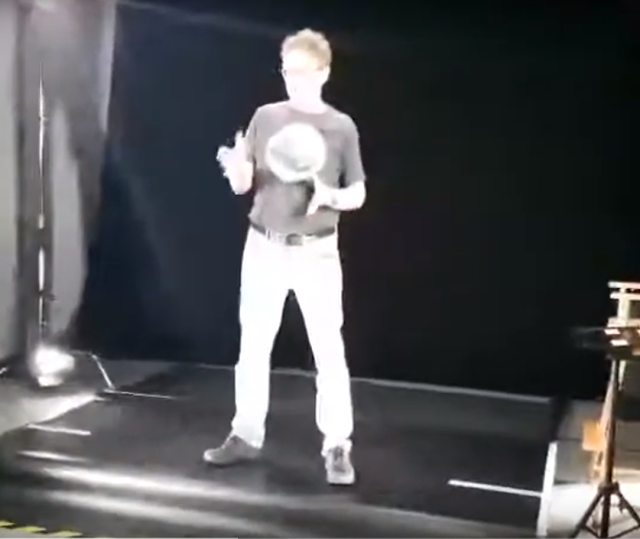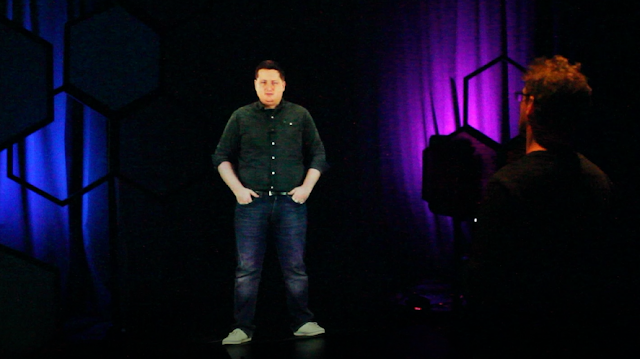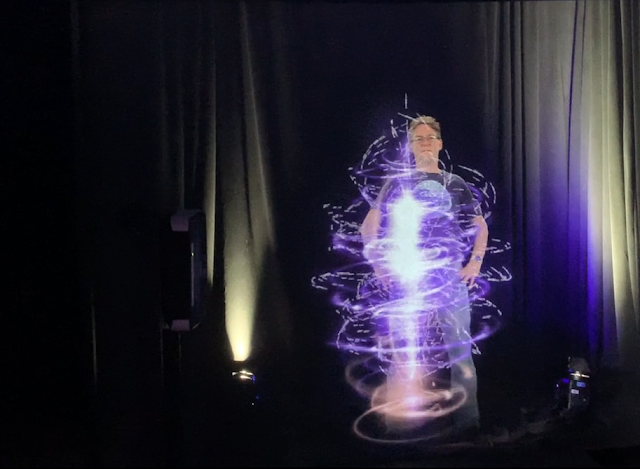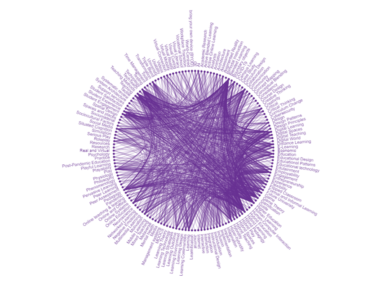Regular Media & Learning contributor, Zac Woolfitt from Inholland University of Applied Sciences in The Netherlands had his first try at being a hologram recently and wrote about it on his blog. With Zac’s permission we have reproduced his post here.
Check out the video of my first appearance as a Hologram.
Reflections on appearing live as a HumaGram™ in another country
- What would it be like to teach as a hologram?
- What possibilities do hologram teachers offer higher education?
Got to try it
In my quest to experience and reflect on all forms of ‘Video Teaching’, I just had to try this out! On 20th February, I visited the ARHT studio in London. Rory Elliot, head of EMEA, kindly set up a demo session where I could explore these questions.
Capture Studio Set-up
I stood on a slightly raised black stage with a black background. There were two side lights, two back lights and one overhead light. These illuminated the ‘edges’ of my body. I was wearing a long sleeved black shirt which was no good! So I took that off and appeared in my rather informal T-shirt and bare arms which were more visible.

The camera was about 50cm off the ground and about 6 meters away. This allows for me to be captured from head to toe. Since the capture camera is quite low off the ground, you need to look down a bit when presenting to give the impression you are looking into the eyes of the person you are talking to at the other end.

Teaching as a hologram
I stood on the stage and could be quite relaxed as I moved around and engaged with Brandon in the Toronto office. I had an audio device so I could hear him. There was a ceiling microphone picking up my voice. The lights were quite bright and I had to focus on looking down to the capture camera close to the floor. But the active posture meant it was quite a natural position for a conversation. I focused on concentrating on communicating to the viewer ‘through’ the camera lens. Having done this once and seen the results, next time I would envision myself as the clearly visible live presence on the screen in the other room. With that in mind, you can be even more relaxed and confident knowing that you are being seen and heard very clearly at the other end. Only a certain area around you is recorded so you need to stay in one place to avoid losing your hands as you talk.
The image is projected into a viewing room. A projector to the right of the screen shines the image onto the screen. Behind the screen are curtains. So the hologram image appears to be standing on the stage.

Wow Factor
This is quite a transformation in video conferencing. It harkens back to the 3d hologram image of Princess Leia in Star Wars. There is certainly a novelty effect in the ‘Wow’ factor. Being a hologram could be quite effective in getting information across. It is harder to look away. As a viewer you are very engaged. There is almost no delay and it feels more personal than just a normal flat screen. Perhaps in 20 years’ time we will all be teaching and learning via holograms. It may seem totally standard. But for the moment it is exciting and ground-breaking.
Is it worth it?
For a standard lecture or lesson in a classroom with regular content, I don’t yet see the added value of the hologram lecturer. Higher Education has to ensure that the social element of the teaching and learning process is enhanced. Students come to higher education to learn in a social context. Holograms are not yet ready to replace face-to-face teaching.
However, there are huge benefits in being able to get the scarce resource of a world renowned expert to present in different locations. And the live and interactive format means that there can be a Q and A discussion. The sense of personal context, and being able to stand physically close to the expert increases the attention and involvement of the viewer. The studio setting, good lighting and audio, enhance and intensify the human interaction.
3d to 2d back to 3d
The experience is very different to a flat screen. The hologram appears to be really in the room with you. You keep forgetting that you are talking to a screen. The hologram is a surface with light projected on it. But it seems like the person is actually there. So you are an avatar basically. It appears the hologram is here in the flesh.
When you video your teaching your 3d self is digitalised and flattened to be ‘distributed’ via 2d. The hologram process re-humanises this 2d self. It creates the perception of a 3d presence. This is the re-3d-ing of the 2d self. In a Skype or Zoom session viewers may be sitting behind a computer or viewing via a smartphone. This viewing experience can be lean-back, and less active. The flat screen removes an element of the humanness and it remains 2 dimensional. But with the hologram presence, there appears to be an intensified level of engagement.
For the best perspective, you should view the hologram straight on. If there is light on the background curtains, and you view it slightly from the side, then you start to see ‘through’ the image. For large audience presentations, effort is taken to ensure a fully black background. So from the side, you may appear ‘thinner’ than normal, but you will still appear to be solid.

If there is light on the curtains, you may appear see-through from the side. But when blacked out, you remain solid.
Beam me up
At the end of my session, I was beamed away. The cool visual effect and sound adds to the whole experience. It supports the sense of presence that the individual was actually there but has been magically ‘beamed-back’ to another distant location. Watch the recording process in the capture studio in London.
I talk live to my first hologram
Earlier that day, I had walked into the projection studio to meet my first live hologram. I saw a man standing there. I felt a bit embarrassed that I had kept him waiting. This was Brandon Pratt, studio manager in Toronto. He appeared live from Toronto as a 3d hologram in the London studio. I soon forget I was talking to a hologram and we had a normal conversation. Watch the full interview with subtitles.

Seeing is believing
Brandon and I talked in real time with only a minimal (0.3 seconds) time lag. The person appearing in front of you is life sized. Their video image is projected onto a transparent screen. A few feet behind the screen is the back wall of the studio with curtains. The hologram appears to be standing right there in front of you. Your brain is convinced that the person in front of you is really there. Brandon shared with me ARHT Media’s latest developments.
‘Holo University’ and the future of Higher Education
ARHT Media have a vision to develop a ‘Holo University’. Faculty would be at one location and would be beamed to students at multiple locations. Currently they are working with business schools, engineering schools and medical schools. These universities are forward thinking and have the budgets to push the new technology. They can bring in a top speaker or world renowned expert.
5G and beyond
ARHT Media are developing a lightweight and portable HoloPod. With the advent of 5G, this will enable receiving the holograms at different locations. The goal is to reduce the complexity of the process. Sufficient designated bandwidth is needed to ensure a smooth experience. You still need a capture studio to record the 3d image (see below). From one capture studio you can be beam to many locations.
Live or recorded
A hologram can appear live with synchronous interaction with the audience. Another option is to pre-record the content, and then use this recording multiple times. A top speaker could give a key note presentation against a green screen. You can then add animations around it in post-production. ARHT media can do a one-off event. The equipment is rented from local suppliers. The projection side of things uses standard, off the shelf equipment. The studio requires more complicated elements. Currently the person being captured needs to go to one of the capture studios, as I did. Or the client can buy the studio, projection equipment and software and run it themselves.
Medicine and Music
One area leading the development is the world of medicine. If you’ve got the private funding, you can have a top medical expert can consult you via hologram. This decreases the carbon footprint and allows for several synchronous consultations at different geographic locations. For medical emergencies, a hologram expert could be present live to advise on procedures.
Several musicians have already appeared on stage live, or posthumously, as holograms. There is the option to bring musicians together from different locations to play on stage ‘together’. A saxophone player in Canada and a guitar player in Amsterdam could be combined into one performance. A pretty amazing idea.
According to Brandon, some of the ARHT Media clients have seen that when someone presents as a hologram that there is more retention of the information presented. It would be interesting to collect empirical data on this in a research context.
Thank you!
I would really like to thank everyone at ARHT Media for their help in setting up this session. In particular Rory Elliot in London and Brandon Pratt in Toronto.
ARHT Media
ARHT Media, based in Toronto, have pioneered Augmented Reality Holographic Telepresence technology. An individual is ‘captured’ in one studio and projected live as a life-sized, 3d hologram, into a location anywhere in the world. They call this the ‘world’s first complete end-to-end solution for the creation, transmission, and delivery of lifelike digital human holograms, known as HumaGrams™. In addition to their Toronto headquarters there are demo studios in London, New York, Los Angeles, Hong Kong and Fuzhou in China. Background on ARHT Media can be found here along with a recent financial report here.














